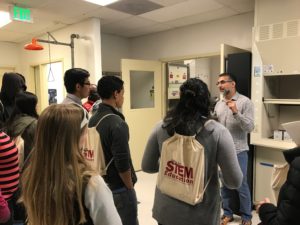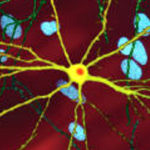The projects of 21 Biosciences Area scientists and engineers received funding through the FY24 Laboratory Directed Research and Development (LDRD) program.
R&D 100 Awards Are In!
Seven innovative technologies from Berkeley Lab have been honored with a 2022 R&D 100 Award. Biosciences Area researchers contributed to two different products that were awarded.
Cell ‘Fingerprinting’ Could Yield Alzheimer Disease Diagnostic
A technology developed by Cynthia McMurray, a senior scientist in the Molecular Biophysics and Integrated Bioimaging Division, and her team shows great promise for diagnosing Alzheimer disease before symptoms arise. This disease affects millions of people worldwide and is estimated to be the sixth leading cause of death in the United States.
Astrocyte Insight Explains Brain Region-specific Vulnerability in Huntington Disease
The mutant form of the Huntington gene, mHTT, which encodes a product that causes the disease, is expressed throughout the brain in affected individuals. Yet neurons in individual regions of the brain are differentially susceptible to its neurotoxic effects. The basis for this puzzling region-specific vulnerability in Huntington disease—which is likewise a feature of Alzheimer and Parkinson neurodegenerative diseases—was hitherto unknown.
A new study led by Cynthia McMurray, a senior scientist in Molecular Biophysics and Integrated Bioimaging (MBIB), provides evidence that regional differences in neuronal susceptibility to Huntington disease can be attributed to substrate-driven metabolic reprogramming strategies adopted by astrocytes in response to low glucose. The team recently reported their findings in the journal Cell Metabolism.
Biosciences Participates at East Bay STEM Career Awareness Day
 Biosciences Area researchers and staff participated at the annual East Bay STEM Career Awareness Day on April 27, 2017, at Wareham Development’s Aquatic Park Center in West Berkeley, home to Biosciences Operations @ Berkeley and several Area research groups.
Biosciences Area researchers and staff participated at the annual East Bay STEM Career Awareness Day on April 27, 2017, at Wareham Development’s Aquatic Park Center in West Berkeley, home to Biosciences Operations @ Berkeley and several Area research groups.
The event was led by Cal State University East Bay’s Institute for STEM Education in partnership with local businesses and organizations, and was aimed at providing insight into potential STEM careers and educational opportunities in the region. Three hundred high school students from Berkeley, Emeryville, Oakland and Richmond engaged in activities around this year’s theme:, “What problem(s) are you trying to solve?” Students had the opportunity to network with a variety of STEM professionals during tours, a working lunch and exhibitor tabling.
Was this page useful?








